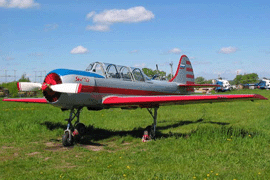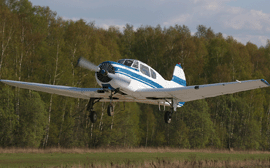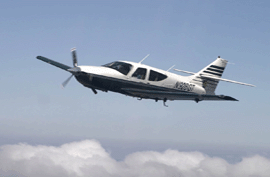|
|
 |
Gifts and presents
stuff.
FLYING presented as a gift.
Yak-52
The Yakovlev Yak-52 (Як-52) is a Soviet primary trainer aircraft which first flew in 1976. It is still being produced in Romania by Aerostar, which gained manufacturing rights under agreement within the now defunct COMECON socialist trade organisation. The Yak-52 was designed originally as an aerobatic trainer for students in the Soviet DOSAAF training organisation, which trained both civilian sport pilots and military pilots.
Since the early 1990s and the fall of the Soviet Union, many Yak 52s have been exported to the west. Of the approximately 1,800 produced to date, most now fly in the United States, United Kingdom, New Zealand, Australia and other western
countries. |

|
| The Yak-52, like most Soviet military aircraft, was designed to operate in rugged environments with minimal maintenance. One of its key features, and a radical departure from most western aircraft, is its extensive pneumatic system. Engine starting, landing gear, flaps, braking and steering are all pneumatically actuated. Spherical storage bottles for air, replenished by an engine driven compressor, are situated behind the rear cockpit and contents displayed on the instrument panels. The operating pressure is between 10 and 50 bars (145 and 725 psi) and an emergency circuit is reserved for lowering the undercarriage if the normal supply is exhausted or the compressor fails. Additionally both main and reserve bottles can be charged from a port on the ground with compressed air, usually from a Scuba type air bottle. The steering/braking arrangement, especially, takes some adjustment for flyers accustomed to hydraulics, because the plane uses differential braking controlled by rudder pedals and a hand operated lever on the control stick.
General characteristics
* Crew: 2
* Length: 7.745 m (25 ft 5 in)
* Wingspan: 9.3 m (30 ft 6 in)
* Height: 2.7 m (8 ft 10 in)
* Wing area: 15 m² (161.5 ft²)
* Empty weight: 1,015 kg (2,238 lb)
* Loaded weight: kg (lb)
* Max takeoff weight: 1,305 kg (2,877 lb)
* Powerplant: 1× Vedeneyev M-14P 9-cylinder radial engine, 268 kW (360 hp)
Performance
* Never exceed speed: 419 km/h (450 km/h with all AD's) (226 kn, 260 mph)
* Maximum speed: 272 km/h (147 kn, 169 mph)
* Cruise speed: 237 km/h (128 kn, 147 mph)
* Stall speed: 111 km/h (60 kn, 69 mph)
* Range: 510 km 275 mn as standard or with long range fuel 1,000+ (317 mi standard, 621+ mi long range)
* Service ceiling: 4,000 m (13,123 ft)
* Rate of climb: 7 m/s (1,400 ft/min)
|
Yak-18T
The Yakovlev Yak-18T is a four-place, fully aerobatic utility aircraft. Introduced to train Aeroflot pilots, it has recently gained some popularity as a sportplane in both the East and the West. It is powered by a 268-298 kW (360-400 hp) Vedeneyev M14P radial engine, and is designed for stresses of +6.4/-3.2
g. |
 |
Although derived from the Yak-18 series of two seat trainers that first flew in 1946, the Yak-18T has very few components that can be traced to its earlier forebear, and can be considered a unique design, despite its nomenclature. The design and engineering changes include a larger cabin with seating for four, tricycle undercarriage (single seat Yak-18PMs had tricycle undercarriage also), as well as the 265 kW (355 hp) Vedneyev M14 nine cylinder radial engine being installed.
Compared with other four-seat light aircraft such as the Cessna 172 or the Piper PA-28, the Yak-18T is only a little wider and longer but it is much heavier and is equipped with a considerably more powerful engine. The Yak-18T is perhaps better compared with the Piper Saratoga which has two extra seats but which has a similar maximum weight, together with a retractable undercarriage and a similarly powerful engine. The Yak-18T is, however, distinguished by its strong construction, aerobatic capability and docile yet responsive handling characteristics.
The Yak-18T prototype had its first flight in mid-1967 and subsequently the type was placed in series production in
Smolensk.
General characteristics
* Crew: one, pilot
* Capacity: Three or four passengers
* Length: 8.39 m (27 ft 6 in)
* Wingspan: 11.16 m (36 ft 7 in)
* Height: 3.40 m (11 ft 2 in)
* Wing area: 18.9 m² (203.36 ft²)
* Empty weight: 1,240 kg (2,734 lb)
* Loaded weight: 1,650 kg (3,638 lb)
* Useful load: 410 kg (904 lb)
* Powerplant: 1× Vedeneyev M14P 9-cylinder air-cooled radial engine, 268 kW (360 hp)
Performance
* Never exceed speed: 300 km/h (162 kn, 186 mph)
* Maximum speed: 262 km/h (141 kn, 162 mph)
* Cruise speed: 200 km/h (108 kn, 124 mph)
* Stall speed: 114 km/h idle, gear & flaps down (61 kn, 71 mph)
* Range: 760 km (410 nmi, 470 mi) no reserve, standard 193 l (51 US gal) fuel
* Service ceiling: 4,000 m (13,000 ft) without oxygen
|
Rockwell Commander 112TCA
The Rockwell Commander 112 is an American four-seat single piston-engine cabin monoplane designed and built by North American Rockwell (later Rockwell International) in the 1970s. A developed version was also built by Commander Aircraft in the 1990s and early 2000s, and as of late 2008 the type is due to go into production again in the near future.
Contents
|
 |
In 1970 Rockwell designed and built two versions of a four-seat cabin low-wing monoplane; the fixed tricycle landing gear Commander 111 and the retractable tricycle landing gear Commander 112. Only two prototype Commander 111s were built; the company decided that only the Commander 112 would go into production. A prototype Commander 112 crashed after the tail failed during testing, which led to a redesign of the tail unit; this delayed the delivery of the first production aircraft until late in
1972.
The 112 prototypes were powered by a 180hp (134kW) Lycoming O-360 engine; this was replaced by a 200hp (149kW) IO-360 engine in production
aircraft. After 123 production aircraft had been built a number of improvements were made to the 112 in 1974, including an internally-redesigned wing with increased fuel capacity and a 100lb increase in maximum take off weight (MTOW) to
2,650lbs; 112s built to this standard were marketed as Commander 112As. After another 30 112s were built, Rockwell offered purchasers of 112s the option of having their aircraft built with the increased 68 US gallon fuel capacity or with a reduced fuel capacity of 48 US
gallons.
Rockwell introduced a new model of the 112, the Commander 112TC with a turbocharged engine of 210hp and another increase in MTOW
(to 2,850lbs), in 1976. Also introduced that year was the Commander 114 with a more powerful six-cylinder Lycoming IO-540 engine of
260hp. The 112, 112TC and 114 were all subsequently upgraded, to the 112B, 112TCA and 114A
respectively. The final year of production was 1979, by which time the marketing name Alpine Commander was used for the 112TCA and Grand Turismo Commander for the 114A.
General characteristics
* Crew: 1
* Capacity: 3 passengers
* Length: 25 ft 0½ in (7.63 m)
* Wingspan: 35 ft 7¼ in (10.85 m)
* Height: 8 ft 5 in (2.57 m)
* Wing area: 163.80 ft² (15.22 m²)
* Empty weight: 2070 lb (939 kg)
* Gross weight: 3260 lb (1479 kg)
* Powerplant: 1 × Lycoming IO-540-T4B5D, 260 hp (194 kW)
Performance
* Maximum speed: 191 mph (307 km/h)
* Range: 813 miles (1308 km)
* Service ceiling: 16,500 ft (5030 m)
|
|

